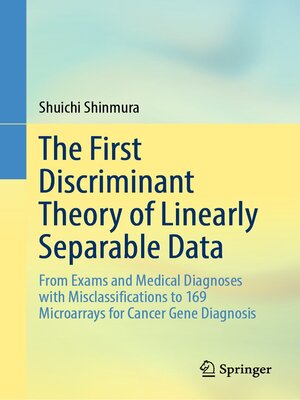The First Discriminant Theory of Linearly Separable Data
ebook ∣ From Exams and Medical Diagnoses with Misclassifications to 169 Microarrays for Cancer Gene Diagnosis
By Shuichi Shinmura

Sign up to save your library
With an OverDrive account, you can save your favorite libraries for at-a-glance information about availability. Find out more about OverDrive accounts.
Find this title in Libby, the library reading app by OverDrive.



Search for a digital library with this title
Title found at these libraries:
| Loading... |
This book deals with the first discriminant theory of linearly separable data (LSD), Theory3, based on the four ordinary LSD of Theory1 and 169 microarrays (LSD) of Theory2. Furthermore, you can quickly analyze the medical data with the misclassified patients which is the true purpose of diagnoses. Author developed RIP (Optimal-linear discriminant function finding the combinatorial optimal solution) as Theory1 in decades ago, that found the minimum misclassifications. RIP discriminated 63 (=26−1) models of Swiss banknote (200*6) and found the minimum LSD: basic gene set (BGS).
In Theory2, RIP discriminated Shipp microarray (77*7129) which was LSD and had only 32 nonzero coefficients (first Small Matryoshka; SM1). Because RIP discriminated another 7,097 genes and found SM2, the author developed the Matryoshka feature selection Method 2 (Program 3), that splits microarray into many SMs. Program4 can split microarray into many BGSs. Then, the wide columnLSD (Revolution-0), such as microarray (n<p), is found to have several Matryoshka dolls, including SM up to BGS.
Theory3 shows the surprising results of six ordinary data re-analyzed by Theory1 and Theory2 knowledge. Essence of Theory3 is described by using cephalopelvic disproportion (CPD) data. RIP discriminates CPD data (240*19) and finds two misclassifications unique for cesarean and natural-born groups. CPD238 omitting two patients becomes LSD, which is the first case selection method. Program4 finds BGS (14 vars.) the only variable selection method for Theory3. 32 (=25) models, including BGS, become LSD among (219−1) models. Because Program2 confirms BGS has the minimum average error rate, BGS is the most compact and best model satisfying Occam's Razor.
With this book, physicians obtain complete diagnostic results for disease, and engineers can become a true data scientist, by obtaining integral knowledge ofstatistics and mathematical programming with simple programs.






